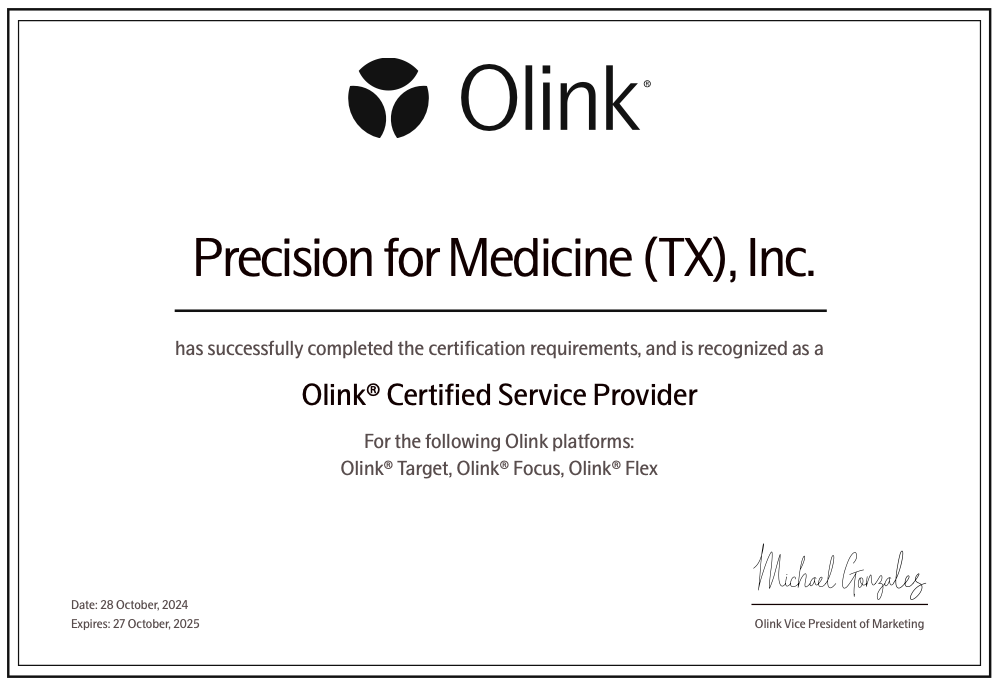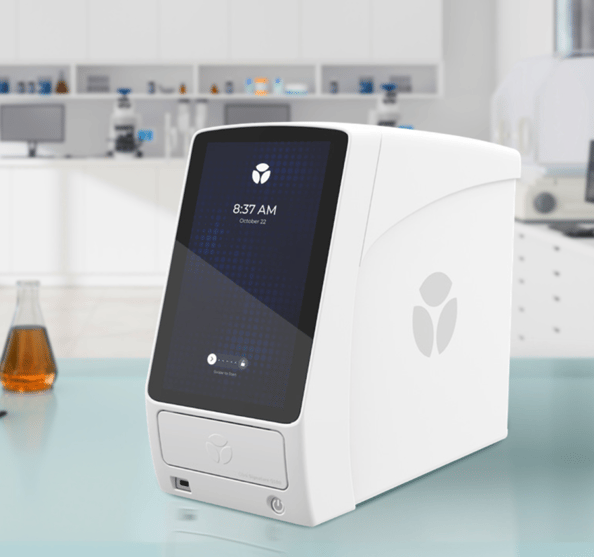

Olink® Proteomics
Olink® offers a high-throughput solution for protein biomarker discovery with thoroughly validated assays that provide exceptional specificity at high-multiplex levels. Widely used in clinical biomarker research, Olink can be applied across all stages of drug development, from early discovery through preclinical and clinical development to postapproval activities such as postmarket surveillance and label expansion.
Precision for Medicine is a certified Olink® Service Provider.
Precision customizes our Olink services to meet your specific study objectives
Our Precision team will work with you to discuss proteomic biomarker needs for clinical trials, for example to help you investigate the mechanism of action of your new therapeutic or narrow down your list of potential clinical biomarkers to meet your endpoints. Below is a selection of some of the ways in which we can utilize Olink for your projects.
Drug Target Identification
-
Identify protein quantitative trait loci (pQTLs) to link genetic variation, proteins, and disease
-
Gain insight into tumor biology, mechanism of immune modulation, phenotype changes, transformation of cold to hot tumors
Biomarker Analysis & Screening
-
Analyze longitudinal biomarker data between early and later timepoints to identify key biomarkers associated with drug-sensitive to drug-resistant state transitions
Protein Response Validation in Clinical Trials
-
Predict and monitor treatment response, treatment sensitivity, and mechanism of immune resistance
-
Guide strategy to optimize response rates and identify novel targetable pathways
Exploratory Endpoints in Clinical Trials
-
Examine the association of circulating protein biomarkers with clinical outcomes
-
Predict onset and mechanism of treatment-associated toxicity, monitoring cytokine release syndrome and neurotoxicity
-
Predict recurrence and on-treatment progression in adjuvant settings

An Olink® Certified Service Partner
Our Precision staff have undergone rigorous training, annual concordance testing and re-certification to demonstrate their ability to perform Olink workflows with the highest quality and consistency.

How does Olink work?
Olink’s Proximity Extension Assay (PEA) uses 2 matched antibodies per target antigen. Each antibody pair is labeled with unique DNA oligo barcodes. When the antibodies bind to the same target protein in solution, the DNA oligo strands anneal with enough stability to enable DNA extension. The DNA barcode is then amplified, and the resulting amplicons are measured by qPCR or next-generation sequencing for absolute or relative quantification.
The integration of the Olink Signature Q100 instrument allows for the high-multiplex technique of the quantification of protein biomarkers with
- Minimal clinical sample volume (as low as 1 µL of plasma/serum)
- Exceptional sensitivity and specificity
- Coverage of a broad dynamic range
- A wide range of accepted biologic sample types
Olink panels scale from midplex Olink Target 48 and Olink Target 96 down to customized Olink Focus and Olink Flex.
Olink’s prevalidated and custom panels
| Olink Target 96 | Olink Target 48 | Olink Flex | Olink Focus |
|---|---|---|---|
| Choose from 15 thoughtfully designed panels and measure up to 92 proteins per panel. Examples of Target 96 Panels : Cardiovascular II & III, Oncology, Cardiometabolic, Neurology, Cell Regulation Inflammation, Immuno-oncology, Metabolism |
Target 48 cytokine panel measures 45 carefully selected inflammatory proteins. | Customizable made-to-order panel enables the selection and combination of up to 21 human proteins. Mix and match from ~200 thoroughly prevalidated protein biomarkers. | Customized panels for specific and exclusive studies are designed and optimized together with Link. Select up to 21 proteins from Olink’s full assay library |

Discover how our Olink services can advance your development program
Additional cytokine and protein profiling services
-
Explore


Western blotting
ExploreProviding western blotting via automated platforms to ensure accurate, reproducible results
Western blotting
ExploreProviding western blotting via automated platforms to ensure accurate, reproducible results -
Explore


MesoScale Discovery (MSD)
ExploreMeasuring a range of analytes in complex sample matrices consistently and at high sensitivity, with applications including ADA, NAb, TAb, and PK assays
MesoScale Discovery (MSD)
ExploreMeasuring a range of analytes in complex sample matrices consistently and at high sensitivity, with applications including ADA, NAb, TAb, and PK assays -
Explore


Luminex®
ExploreLuminex is useful when multiplexed measurements at high sensitivity, even in complex matrices, are needed. We generally utilize the Luminex platform in early phase studies profiling cytokines and other analytes.
Luminex®
ExploreLuminex is useful when multiplexed measurements at high sensitivity, even in complex matrices, are needed. We generally utilize the Luminex platform in early phase studies profiling cytokines and other analytes.